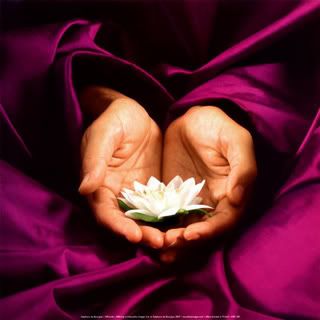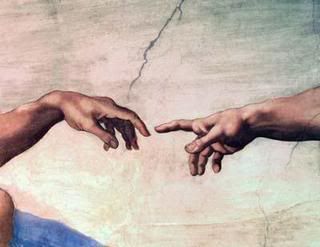
The hands are the two intricate, prehensile, multi-fingered body parts normally located at the end of each arm of a human or other primate. They are the chief organs for physically manipulating the environment, using anywhere from the roughest motor skills (wielding a club) to the finest (threading a needle), and since the fingertips contain some of the densest areas of nerve endings on the human body, they are also the richest source of tactile feedback so that sense of touch is intimately associated with human hands. Like other paired organs (eyes, ears, legs), each hand is dominantly controlled by the opposing brain hemisphere, and thus handedness, or preferred hand choice for single-handed activities such as writing with a pen, reflects a significant individual trait.
No big surprise then that we feel the need to engage our hands when riding before any other part of our body. It is a huge part of my current path towards perfection.....of course I won't ever be perfect but just aiming for it seems to make the effort worthwhile.
At the end of the summer I learnt my greatest lesson in hands....EVER. I had been taught and then taught others to keep my reins within my fingers, not in a tight grip but certainly in a way that if the horse tried to pull the reins from my grip that I would at all times be ready. Imagine my disbelief that I could ride with the reins solely poised between my thumb and forefinger, leaving the remaining three fingers to *play* the reins like the lightest fingers on a harp. Vibrate, close (not just the hand but ONE finger at a time) indeed create a melody between bit and hand that is always individual, fresh and lively.
I'm still struggling with this, I can find very little in the way of backup from literary sources (please tell me if you find some) and the nearest (although it falls very short of the feeling it gives) is the description L'Hotte gives of the Comte D'Aure's hands *He only used the pressure of his fingers, which were always gentle, and played with the reins as though they were light ribbons he feared could break*
I will add to this in future but as you may have guessed I am still trying to figure out the whole picture.
OK, this is an edit after I published the first message but I didn' want to loose it amongst the comments, however, after searching some more I found this on the CD list and the poster describes exactly what I'm talking about ***************
I know that many won't agree, but I state it simply for you to know that there are other approaches out there too.There are those who use a hand in which the neutral position is moreopen in the lower fingers (maintaining the reins held between thethumb and index. I am one of them. Closing the fingers on the reinsis an action for me. The default neutral position is more open. Ibelieve that this makes it easier to teach the horse to really go inself carriage, liberty on parole, simply by opening the fingers alittle. I can obviously conceive that this is also possible with aclosed fist. But I imagine it more difficult both for horse andrider.Philippe Karl describes this well in his new book, saying that you donot try to play the piano with your fists and that riding should bethe same. I have seen many really interesting riders get very goodresults with very average horses with a hand like this, so somethingmust be interesting in there somewhere.But of course it is not just about your fingers and fists, it isabout educating the mouth and the attitude you have as well -recently talking with Bettina Drummond, she made a very interestingcomment, something along the lines of the fact that many ridersfalsely believe that they "own" the "mise en main" (softening to thehand), when in fact it should be the horse that keeps its ownership.Which highlights why the subject also runs into difficulty - becauseeveryone also has their own perception of how much they "leave" tothe horse, and how much the "take" for themselves. Which can explainwhy sometimes I watch riders on very nice horses, going very well andclassically and it just does not do it for me. They have taken toomuch for my taste, all I see is the rider. Then I watch another andall I see is the horse, and that, for me, is the goal! But someoneelse may not find what they are looking for in that, because thatpoint is unimportant for them, and there are other points that theyfind missing.Anyway, there's another perspective, strike me down and boil me inoil for such heretic thoughts! LOL
***********************************
phew, glad I wasn't imagining it, off to bed happy then :-)


4 comments:
i think that's the problem with most instruction - instructors SAY hands when what they mean is FINGERS
i have read it somewhere, can't quite remeber where - but a BHS II told me about fingers some years ago ... not that i can ALWAYS remember!
Claire this is so not BHS but maybe she was a french classicist too. The only hope I have at the moment is Racinet (and I'm not THAT struck on him) but I've tried Baucher, L'Hotte, Belasik, Seunig, Burger et al and no-one describes what my lastest teachings have been. The fingers can rest open, the rein caught just between the thumb and forefinger; I always used my fingers before but not in such a colurful way as this. I'll find it somewhere but if you find it first let me know, lol
When I read this, my first thought was Racinet. I think he advocates the "plier of thumb-index finger, with hand "ajar", fingers able to open and close. Not sure which book, I think "Another Horsemanship"
It should be intersting Trudi, knowing your "aversion" to Racinet. LOL!!
another who immediately thought "Racinet", when reading your post ;).
what a nice write-up....thanks for the linky!
:)
Trish
Post a Comment